Forward thinking retailers are taking advantage of current market conditions to relocate and expand store operations.
Forward thinking home furnishings retailers are taking advantage of the competitive landscape by moving, renovating and expanding store operations. The slow economy in many areas of the country has produced some excellent deals in leasing and purchasing real estate. This is good news for storeowners seeking to increase their market share situation.
Great opportunities often come along with a degree of risk, and moving a store is no exception. The process is complicated and requires competencies you may or may not have within your organization. Good planning is essential if you want to accomplish a move flawlessly and within budget. Still, even if your planning is near perfect; when staff, contractors, weather, local planning boards and inspectors interact… things can spin out of control. Without a good plan and good people who know what they need to do, you are asking for trouble.

If you are planning a move, the following checklist can be used to help you to start thinking about putting together a plan. Some are obvious and others you just don’t want to forget.
1) Assign a project manager to oversee the new construction or renovation. Bring your entire team into the process because every area of your business from information technology to the delivery staff will be involved. Charge the project manager with producing a timetable and letting other members of the team know what is expected of them and when. Good communications throughout the process is most important.
2) Find a prime location.
3) Obtain a set of complete structural drawings. These must include electrical, plumbing, a site drawing, HVAC and sometimes a structural engineering drawing. It is important that these plans be as accurate as possible because subsequent changes may require resubmission to the zoning board, resulting in long delays.
4) Prepare drawings of outside signage per code. Every municipality has a different code for signage. You will either need to familiarize yourself with the code or hire a local sign company to do the work.
5) A furniture floor plan/slot count, wall partition plan, lighting schematic drawing, and room colors/floor covering plan are needed. Make early contact with the board and building inspectors. Try to establish a relationship on a first-name friendly basis. This is not always easy to accomplish. Early communication with the local municipality is important. Try and figure out what expectations they have for your building or remodeling project.
6) Send out bids for sub contractors, general contractors, or both. Try to seek bids from a general contractor first. They will have the ability to handle more of the required project based on the drawings. Many projects run into trouble when tradespeople, who are not used to working as a team, run afoul of each other. An experienced general contractor can bring in people who will work together well. Again, try to employ local contractors, and always try to get at least three bids. Make sure contractors have adequate insurance (including workman's comp). If a general contractor cannot be found, then you must become your own general contractor and find your own subcontractors.
7) Gather all figures and estimates together to make a decision regarding what companies should do your job. Check references carefully and make sure everyone is bidding exactly the same way. Specify the completion date with penalties for each contractor.
8) On the top of page thirty-three is a list of trades that are usually needed to complete a project. These people need to be handled like a professional ball team. A good project management company is, therefore, required.

Case Study #1
FUTURAMA: BIG BOX TO LIFESTYLE STORE
"When the times are bad, you can either accept it as being bad, or you can flip the coin over and use the bad times to your advantage," said Alex Mehran, CEO of Futurama Home Furniture, whose New York based company flipped the coin to its advantage by leasing a "big box" space at a reasonable price.
In a highly competitive stretch of Route 46 in Fairfield, New Jersey, the retailer opened a 90,000 S.F. store in what had been warehouse space for Levitz Furniture. Futurama Home Furniture has showrooms in New York City, Westchester and Dutchess County. Opened on President's Day, the Fairfield Futurama store is the largest furniture store in the New York metropolitan area.
"When choosing a location we normally consider demographics of the area, traffic patterns and the amount of car lanes. But this situation was a "no brainer," said Mr. Mehran. "There was nothing to be concerned about. We have Levitz and Seaman's on both sides of us."
In the middle is the impressive space built into the former Levitz Furniture warehouse. Since it had never been used as a showroom, the $1.6 million renovation included building internal walls and floors, a security system and installing HVAC systems in the thirty-year old structure.
Alex’s brother, Joseph Mehran, Jr., was the creative and merchandising force behind the new concept store. "We wanted to create a furniture row or furniture mall between Levitz and Seaman's and ourselves, taking as much market share between the three of us in this New Jersey market as possible.” The Landlord spent at least $1 million to replace the roof and improve outdoor parking spaces.

In order to use the height of the space to best advantage, most walls were raised from10 to 12 feet; in some cases from 10 to 14 feet. Thus setup provides flexibility for creating dramatic displays of varying heights. Shoppers’ eyes are kept down toward the merchandising level through the creative use of soffits and regular passageways.
Planning a project of this size requires a lot of time and effort. The construction manager has many fine points to handle. These include: lighting (a major expense), sound systems, sprinkler systems, HVA systems, carpeting, ceramic and vinyl tile, the thickness of walls, the height of walls to paint and many more. You don't realize how much effort you have to put into it prior to getting started. It is a complex process requiring the efforts of individuals and companies with specialized skills.
Futurama used a design company from California, a New York area architect and local contractors. Assigning a diplomatic person to work with local building inspectors is important (See “Space Planning-Part 2” in from the October 2002 issue of FURNITURE WORLD, posted to the Operations Management article index on www.furninfo.com). “Building inspectors from the Fairfield building department were some of the best I've ever worked with. They were very cooperative," said Alex Mehran.
"We chose a merchandising mix competitive with the lower end - but more or less complementary to that part of the market not being addressed by the Seamans' and Levitzs' of the world," said Joe Mehran, Jr.
Merchandise was organized in the store by traditional, contemporary, modern and country lifestyle settings. Due to the large size of this store, departments were further subdivided into bedding, bedroom, dining room and carpet areas. Futurama stores are generally “over-accessorized” and this store is no exception.
The Mehran’s proved that it would have been a mistake to overlook this "big box" space. The latest Futurama Home Furniture Store in Fairfield, New Jersey is an example of the possibilities inherent in adapting and reusing these kinds of spaces.
 |
The Gehman & Co. Store Design Presented A Challenge due to the building’s square outlines (bottom drawing). Interior walls were designed in angles, x-shapes, T-shapes and combinations.
A huge entrance will feature scatterings of furniture and little set-ups to get customers involved. Areas to be subletted, and warehouse/ receiving areas are not shown. Top drawing gives details of the important design area that will include office space, presentation area and play room for children. The design area will be large enough to accommodate 3 or 4 people working together and will have walls lined with racks of carpeting, area rugs, tile, drapery samples, books and catalogs. |
Case Study #2
GROCERY TO CONCEPT FURNITURE STORE
Lee and Ann Gehman founded Holly Tree Farms in 1976 and incorporated in 1984. At that time, their small, high-end shop was located in a restored 18th century barn in Middletown, PA. The Gehman’s lived in the accompanying stone farmhouse while raising their two sons, Hans and Seth.
In 1988 they began operating by appointment only in order to dedicate more time to raising their family. In April 2004 they plan to open under the Gehman & Co. name in Mechanicsburg, PA, this time with the help of their sons.
Management at Gehmans chose to convert a former Giant Food Stores, Ltd. Supermarket location because it had:
•Easy access from major interstate highways.
•Close proximity to a core market targeted by demographic data.
•Close proximity to a business with a complimentary target market.
•Disproportionately large sales in the area, a judgement based on their previous retail experience.
•Excellent lease terms on the space due to the soft commercial real estate market.
While the new store is in a general area of other home-oriented stores, the Gehmans hope to attract complementary businesses to their location at the Upper Allen Plaza, and so revitalize this aging strip mall.
The space in the former supermarket totals 37,500 square feet. Gehman & Co. will display approximately 17,000 square feet of furniture. The company will offer a broad line of high-quality and high fashion merchandise, including furniture, home accessories and wall/ floor/ window coverings.
The design center/workshop and offices will occupy approximately 2,000 S.F. "It was an idea whose time had come," Hans Gehman said about the new design center. It offers in-store and on-site services. The warehouse area will occupy approximately 6,000 square feet. Not counting common areas such as a "break" room and bathrooms, approximately 11,000 square feet remain available for sub-lease from the Gehmans. They seek to lease the space to a business complementary to their own and draw from a common customer base.
The store’s design presented a challenge due to the building’s square outlines. Interior walls were designed in angles, x-shapes, T-shapes and combinations. Older track and antiquated fluorescent tubes will be replaced with new fixtures to improve energy efficiency and merchandising (T8’s replaced by T12’s and parabolics by MR16’s). Customers will be able to glimpse select furniture displays upon entering a 10-foot entry space. A huge entrance will feature scatterings of furniture and little set-ups to get customers involved. Plans specify the incorporation of live plants. The creative use of carpeting and marble flooring will emphasize certain areas.
Demolition of the store’s left facing side will make room for areas devoted to cabinets and kitchens. Back center point at an angle will have a sound room with TV, built-ins and soundproof padded floors (see drawing on page 36). Nearby will be a widened opening leading into a 10' x 10' kids area in the shape of a hat that leads into the design center workshop.
A 12' open space will open into a design center workshop incorporating two offices with windows where designers can create customer presentations. All old air conditioning and heating units will be replaced, ceilings raised and special lighting installed. The design area will be large enough to accommodate 3 or 4 people working together and have walls lined with racks of carpeting, area rugs, tile, drapery samples, books and catalogs.
A whole new corporate identity had to be created so that Gehman & Co. could differentiate the new location and product selection from the old Holly Tree Farms, Inc., while maintaining the solid reputation and history behind the name. New corporate colors - taupe on deep charcoal were selected to convey stability.
Gehman & Co. will be showing a different mix of styles at this new location. With the assistance of former manufacturer's representatives the family decided to change their emphasis from colonial styles. The focus will now be on transitional with a few antique reproductions.
Hans Gehman, business consultant and part of the family ownership team encountered some difficult delays familiar to many furniture storeowners. It took a month to get a building permit and there were points of clarification that were never dealt with.
"Stress can be mitigated by enjoying the challenge of finding creative solutions," said Hans. For example, when the technology budget for the project was tight, Hans used the resources of two friends, recent computer science graduates. Their company Sim System Technology built the servers, wired the network, programmed an inventory control system and built a phone system.
Other resources Hans used and recommends for public information and services are: Penn State Data Center pasdc.hbg.psu.edu (economic and demographic data) Pennsylvania Small Business Development Center www.pasbdc.org (low-cost management training and consulting in cooperation with the Pennsylvania State University system).
His advice to furniture storeowners is to be prepared to be flexible. When everyone else is selling, it is the time to buy. Be prudent, find the best price and get multiple quotes for construction and building service contractors.
Bill Blake is President of WRB Associates a space planning and design firm that creates and maintains retail environments that increase sales per sq. ft. and boosts merchandise turns. Questions can be sent to Bill care of FURNITURE WORLD at wrblake@furninfo.com.